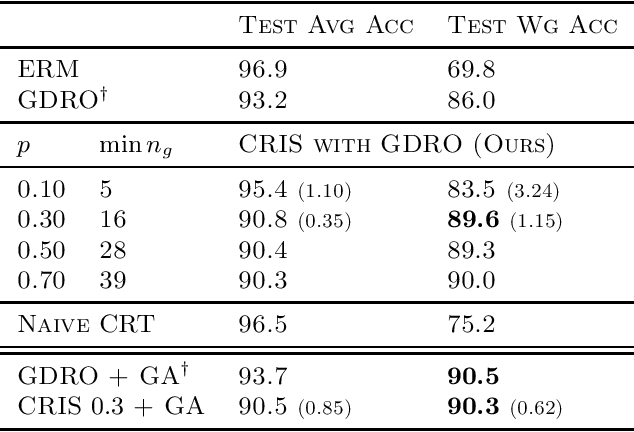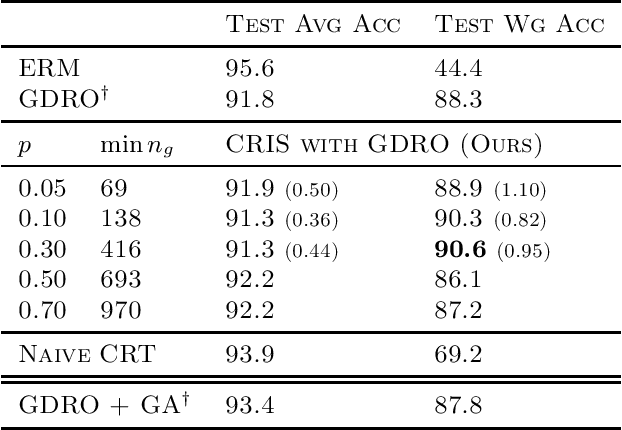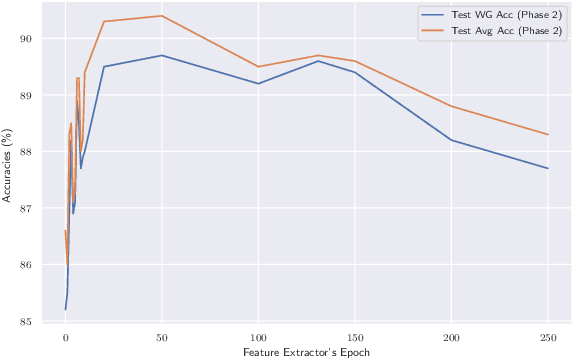Hongyang R. Zhang
Scalable Fine-tuning from Multiple Data Sources:A First-Order Approximation Approach
Sep 28, 2024Abstract:We study the problem of fine-tuning a language model (LM) for a target task by optimally using the information from $n$ auxiliary tasks. This problem has broad applications in NLP, such as targeted instruction tuning and data selection in chain-of-thought fine-tuning. The key challenge of this problem is that not all auxiliary tasks are useful to improve the performance of the target task. Thus, choosing the right subset of auxiliary tasks is crucial. Conventional subset selection methods, such as forward & backward selection, are unsuitable for LM fine-tuning because they require repeated training on subsets of auxiliary tasks. This paper introduces a new algorithm to estimate model fine-tuning performances without repeated training. Our algorithm first performs multitask training using the data of all the tasks to obtain a meta initialization. Then, we approximate the model fine-tuning loss of a subset using functional values and gradients from the meta initialization. Empirically, we find that this gradient-based approximation holds with remarkable accuracy for twelve transformer-based LMs. Thus, we can now estimate fine-tuning performances on CPUs within a few seconds. We conduct extensive experiments to validate our approach, delivering a speedup of $30\times$ over conventional subset selection while incurring only $1\%$ error of the true fine-tuning performances. In downstream evaluations of instruction tuning and chain-of-thought fine-tuning, our approach improves over prior methods that utilize gradient or representation similarity for subset selection by up to $3.8\%$.
Scalable Multitask Learning Using Gradient-based Estimation of Task Affinity
Sep 09, 2024Abstract:Multitask learning is a widely used paradigm for training models on diverse tasks, with applications ranging from graph neural networks to language model fine-tuning. Since tasks may interfere with each other, a key notion for modeling their relationships is task affinity. This includes pairwise task affinity, computed among pairs of tasks, and higher-order affinity, computed among subsets of tasks. Naively computing either of them requires repeatedly training on data from various task combinations, which is computationally intensive. We present a new algorithm Grad-TAG that can estimate task affinities without this repeated training. The key idea of Grad-TAG is to train a "base" model for all tasks and then use a linearization technique to estimate the loss of the model for a specific task combination. The linearization works by computing a gradient-based approximation of the loss, using low-dimensional projections of gradients as features in a logistic regression to predict labels for the task combination. We show that the linearized model can provably approximate the loss when the gradient-based approximation is accurate, and also empirically verify that on several large models. Then, given the estimated task affinity, we design a semi-definite program for clustering similar tasks by maximizing the average density of clusters. We evaluate Grad-TAG's performance across seven datasets, including multi-label classification on graphs, and instruction fine-tuning of language models. Our task affinity estimates are within 2.7% distance to the true affinities while needing only 3% of FLOPs in full training. On our largest graph with 21M edges and 500 labeling tasks, our algorithm delivers estimates within 5% distance to the true affinities, using only 112 GPU hours. Our results show that Grad-TAG achieves excellent performance and runtime tradeoffs compared to existing approaches.
Learning Tree-Structured Composition of Data Augmentation
Aug 26, 2024Abstract:Data augmentation is widely used for training a neural network given little labeled data. A common practice of augmentation training is applying a composition of multiple transformations sequentially to the data. Existing augmentation methods such as RandAugment randomly sample from a list of pre-selected transformations, while methods such as AutoAugment apply advanced search to optimize over an augmentation set of size $k^d$, which is the number of transformation sequences of length $d$, given a list of $k$ transformations. In this paper, we design efficient algorithms whose running time complexity is much faster than the worst-case complexity of $O(k^d)$, provably. We propose a new algorithm to search for a binary tree-structured composition of $k$ transformations, where each tree node corresponds to one transformation. The binary tree generalizes sequential augmentations, such as the SimCLR augmentation scheme for contrastive learning. Using a top-down, recursive search procedure, our algorithm achieves a runtime complexity of $O(2^d k)$, which is much faster than $O(k^d)$ as $k$ increases above $2$. We apply our algorithm to tackle data distributions with heterogeneous subpopulations by searching for one tree in each subpopulation and then learning a weighted combination, resulting in a forest of trees. We validate our proposed algorithms on numerous graph and image datasets, including a multi-label graph classification dataset we collected. The dataset exhibits significant variations in the sizes of graphs and their average degrees, making it ideal for studying data augmentation. We show that our approach can reduce the computation cost by 43% over existing search methods while improving performance by 4.3%. The tree structures can be used to interpret the relative importance of each transformation, such as identifying the important transformations on small vs. large graphs.
Graph Neural Networks for Road Safety Modeling: Datasets and Evaluations for Accident Analysis
Oct 31, 2023Abstract:We consider the problem of traffic accident analysis on a road network based on road network connections and traffic volume. Previous works have designed various deep-learning methods using historical records to predict traffic accident occurrences. However, there is a lack of consensus on how accurate existing methods are, and a fundamental issue is the lack of public accident datasets for comprehensive evaluations. This paper constructs a large-scale, unified dataset of traffic accident records from official reports of various states in the US, totaling 9 million records, accompanied by road networks and traffic volume reports. Using this new dataset, we evaluate existing deep-learning methods for predicting the occurrence of accidents on road networks. Our main finding is that graph neural networks such as GraphSAGE can accurately predict the number of accidents on roads with less than 22% mean absolute error (relative to the actual count) and whether an accident will occur or not with over 87% AUROC, averaged over states. We achieve these results by using multitask learning to account for cross-state variabilities (e.g., availability of accident labels) and transfer learning to combine traffic volume with accident prediction. Ablation studies highlight the importance of road graph-structural features, amongst other features. Lastly, we discuss the implications of the analysis and develop a package for easily using our new dataset.
Boosting Multitask Learning on Graphs through Higher-Order Task Affinities
Jun 24, 2023Abstract:Predicting node labels on a given graph is a widely studied problem with many applications, including community detection and molecular graph prediction. This paper considers predicting multiple node labeling functions on graphs simultaneously and revisits this problem from a multitask learning perspective. For a concrete example, consider overlapping community detection: each community membership is a binary node classification task. Due to complex overlapping patterns, we find that negative transfer is prevalent when we apply naive multitask learning to multiple community detection, as task relationships are highly nonlinear across different node labeling. To address the challenge, we develop an algorithm to cluster tasks into groups based on a higher-order task affinity measure. We then fit a multitask model on each task group, resulting in a boosting procedure on top of the baseline model. We estimate the higher-order task affinity measure between two tasks as the prediction loss of one task in the presence of another task and a random subset of other tasks. Then, we use spectral clustering on the affinity score matrix to identify task grouping. We design several speedup techniques to compute the higher-order affinity scores efficiently and show that they can predict negative transfers more accurately than pairwise task affinities. We validate our procedure using various community detection and molecular graph prediction data sets, showing favorable results compared with existing methods. Lastly, we provide a theoretical analysis to show that under a planted block model of tasks on graphs, our affinity scores can provably separate tasks into groups.
Noise Stability Optimization for Flat Minima with Optimal Convergence Rates
Jun 14, 2023Abstract:We consider finding flat, local minimizers by adding average weight perturbations. Given a nonconvex function $f: \mathbb{R}^d \rightarrow \mathbb{R}$ and a $d$-dimensional distribution $\mathcal{P}$ which is symmetric at zero, we perturb the weight of $f$ and define $F(W) = \mathbb{E}[f({W + U})]$, where $U$ is a random sample from $\mathcal{P}$. This injection induces regularization through the Hessian trace of $f$ for small, isotropic Gaussian perturbations. Thus, the weight-perturbed function biases to minimizers with low Hessian trace. Several prior works have studied settings related to this weight-perturbed function by designing algorithms to improve generalization. Still, convergence rates are not known for finding minima under the average perturbations of the function $F$. This paper considers an SGD-like algorithm that injects random noise before computing gradients while leveraging the symmetry of $\mathcal{P}$ to reduce variance. We then provide a rigorous analysis, showing matching upper and lower bounds of our algorithm for finding an approximate first-order stationary point of $F$ when the gradient of $f$ is Lipschitz-continuous. We empirically validate our algorithm for several image classification tasks with various architectures. Compared to sharpness-aware minimization, we note a 12.6% and 7.8% drop in the Hessian trace and top eigenvalue of the found minima, respectively, averaged over eight datasets. Ablation studies validate the benefit of the design of our algorithm.
Identification of Negative Transfers in Multitask Learning Using Surrogate Models
Mar 25, 2023Abstract:Multitask learning is widely used in practice to train a low-resource target task by augmenting it with multiple related source tasks. Yet, naively combining all the source tasks with a target task does not always improve the prediction performance for the target task due to negative transfers. Thus, a critical problem in multitask learning is identifying subsets of source tasks that would benefit the target task. This problem is computationally challenging since the number of subsets grows exponentially with the number of source tasks; efficient heuristics for subset selection does not always capture the relationship between task subsets and multitask learning performances. In this paper, we introduce an efficient procedure to address this problem via surrogate modeling. In surrogate modeling, we sample (random) subsets of source tasks and precompute their multitask learning performances; Then, we approximate the precomputed performances with a linear regression model that can also be used to predict the multitask performance of unseen task subsets. We show theoretically and empirically that fitting this model only requires sampling linearly many subsets in the number of source tasks. The fitted model provides a relevance score between each source task and the target task; We use the relevance scores to perform subset selection for multitask learning by thresholding. Through extensive experiments, we show that our approach predicts negative transfers from multiple source tasks to target tasks much more accurately than existing task affinity measures. Additionally, we demonstrate that for five weak supervision datasets, our approach consistently improves upon existing optimization methods for multi-task learning.
Generalization in Graph Neural Networks: Improved PAC-Bayesian Bounds on Graph Diffusion
Feb 09, 2023Abstract:Graph neural networks are widely used tools for graph prediction tasks. Motivated by their empirical performance, prior works have developed generalization bounds for graph neural networks, which scale with graph structures in terms of the maximum degree. In this paper, we present generalization bounds that instead scale with the largest singular value of the graph neural network's feature diffusion matrix. These bounds are numerically much smaller than prior bounds for real-world graphs. We also construct a lower bound of the generalization gap that matches our upper bound asymptotically. To achieve these results, we analyze a unified model that includes prior works' settings (i.e., convolutional and message-passing networks) and new settings (i.e., graph isomorphism networks). Our key idea is to measure the stability of graph neural networks against noise perturbations using Hessians. Empirically, we find that Hessian-based measurements correlate with the observed generalization gaps of graph neural networks accurately; Optimizing noise stability properties for fine-tuning pretrained graph neural networks also improves test performance on several graph-level classification tasks.
Robust Fine-Tuning of Deep Neural Networks with Hessian-based Generalization Guarantees
Jun 06, 2022



Abstract:We consider transfer learning approaches that fine-tune a pretrained deep neural network on a target task. We investigate generalization properties of fine-tuning to understand the problem of overfitting, which often happens in practice. Previous works have shown that constraining the distance from the initialization of fine-tuning improves generalization. Using a PAC-Bayesian analysis, we observe that besides distance from initialization, Hessians affect generalization through the noise stability of deep neural networks against noise injections. Motivated by the observation, we develop Hessian distance-based generalization bounds for a wide range of fine-tuning methods. Next, we investigate the robustness of fine-tuning with noisy labels. We design an algorithm that incorporates consistent losses and distance-based regularization for fine-tuning. Additionally, we prove a generalization error bound of our algorithm under class conditional independent noise in the training dataset labels. We perform a detailed empirical study of our algorithm on various noisy environments and architectures. For example, on six image classification tasks whose training labels are generated with programmatic labeling, we show a 3.26% accuracy improvement over prior methods. Meanwhile, the Hessian distance measure of the fine-tuned network using our algorithm decreases by six times more than existing approaches.
Improved Worst-Group Robustness via Classifier Retraining on Independent Splits
Apr 20, 2022



Abstract:High-capacity deep neural networks (DNNs) trained with Empirical Risk Minimization (ERM) often suffer from poor worst-group accuracy despite good on-average performance, where worst-group accuracy measures a model's robustness towards certain subpopulations of the input space. Spurious correlations and memorization behaviors of ERM trained DNNs are typically attributed to this degradation in performance. We develop a method, called CRIS, that address these issues by performing robust classifier retraining on independent splits of the dataset. This results in a simple method that improves upon state-of-the-art methods, such as Group DRO, on standard datasets while relying on much fewer group labels and little additional hyperparameter tuning.
 Add to Chrome
Add to Chrome Add to Firefox
Add to Firefox Add to Edge
Add to Edge